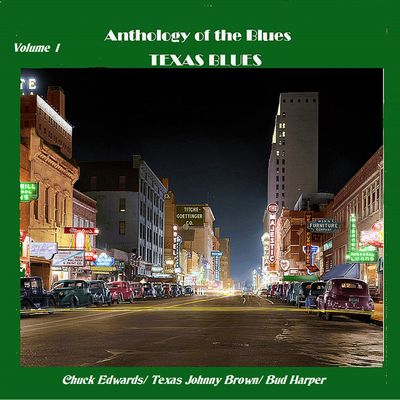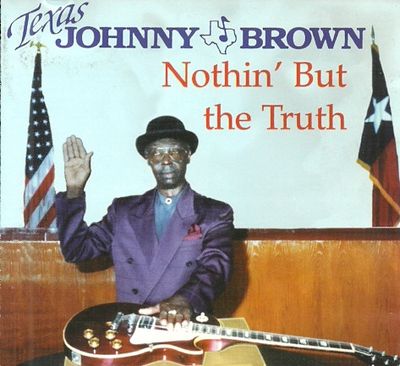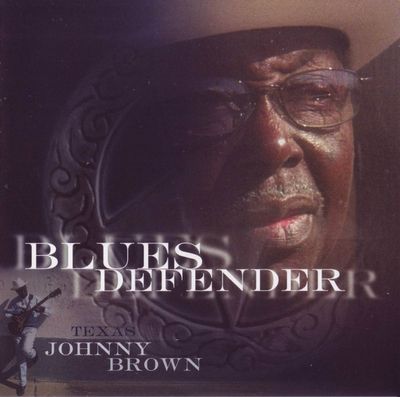John Riley Brown
b. February 22th, 1928 in Ackerman (Mississippi)
d. July 1st, 2013 in Houston (Texas)

TEXAS BLUES vol.1
Blue Eye (only on mp3)
April 1949 - February 1950 / 1961 - 1962
C'est son père qui lui apprend la guitare lorsqu'il est encore enfant. Influencé par T-Bone Walker et Clarence "Gatemouth" Brown, Johnny enregistre d'abord pour Atlantic dans un style Rhythm & Blues typiquement texano-californien et se montre un excellent guitariste ("Bongo boogie", "There go the blues"). Sur ces quelques titres, il est d'ailleurs accompagné du pianiste Amos Milburn. Peu après, il grave une poignée de titres pour Decca ("I'm gonna stop"). Il semble aussi avoir enregistrer pour le label texan ARC avec son père Clarence mais la séance est restée inédite. Plus tard, au début des années 60, "Texas" Johnny Brown grave un simple pour Duke et un autre pour Gene puis part en tournée avec Bobby "Blue" Bland et Junior Parker. En 1963, Johnny abandonne la musique pour s'occuper de sa famille.
It was his father who taught him the guitar when he was still a child. Influenced by T-Bone Walker and Clarence "Gatemouth" Brown, Johnny first recorded for Atlantic in a typically Texas-Californian Rhythm & Blues style and proves to be an excellent guitarist ("Bongo boogie", "There go the blues"). On these few titles, he is also accompanied by pianist Amos Milburn. Shortly after, he records a handful of titles for Decca ("I'm gonna stop"). He also seems to have recorded for Texas-based label ARC with his father Clarence but the session remained unpublished. Later, in the early 60's, "Texas" Johnny Brown cut a single for Duke and another for Gene then went on tour with Bobby "Blue" Bland and Junior Parker. In 1963, Johnny gave up music to take care of his family.

NOTHIN' BUT THE TRUTH
Choctaw Creek
February - June 1995
Après avoir exercé de nombreux métiers, Johnny prend sa retraite en 1991 et rejoint le groupe de Pete Mayes. Il rassemble son propre groupe et propose cet album (qu'il co-prduit avec ses musiciens) qui fut enregistré dans des conditions difficiles (deux musiciens sont décédés avant la fin de la réalisation du CD). On trouve ici un programme consistant de West Coast Blues dans lequel Johnny montre qu'il reste un bon chanteur et un excellent guitariste. On retient notamment "Cheatin' and stealin'", "There goes the blues", "Your house your home", "Strange situation", "No part time lover".
After having practiced many jobs, Johnny retired in 1991 and joined the group of Pete Mayes. He gathers his own group and offers this album (which he co-produced with his musicians) which was recorded in difficult conditions (two musicians died before the end of the production of the CD). Here we find a solid program of West Coast Blues in which Johnny shows that he remains a good singer and an excellent guitarist. We particularly point out "Cheatin' and stealin'", "There goes the blues", "Your house your home", "Strange situation", "No part time lover".

BLUES DEFENDER
Choctaw Creek
September - December 2000
Comme pour l'album précédent, "Texas" Johnny Brown joue parfaitement son Texas Blues cuivré dans lequel son style de guitare subtil se mélange remarquablement. La tracklist se révèle intense et inspirée avec d'excellents moments comme "Handy man", "Did you lose your way", "Run away girl", "Bad hair blues", "Blues defender" et son style Nouvelle Orléans, "Just can't do it".
As with the previous album, "Texas" Johnny Brown perfectly plays his brassy Texas Blues in which his subtle guitar style blends remarkably. The tracklist is intense and inspired with great moments like "Handy man", "Did you lose your way", "Run away girl", "Bad hair blues", "Blues defender" and its New Orleans style, "Just can't do it" .